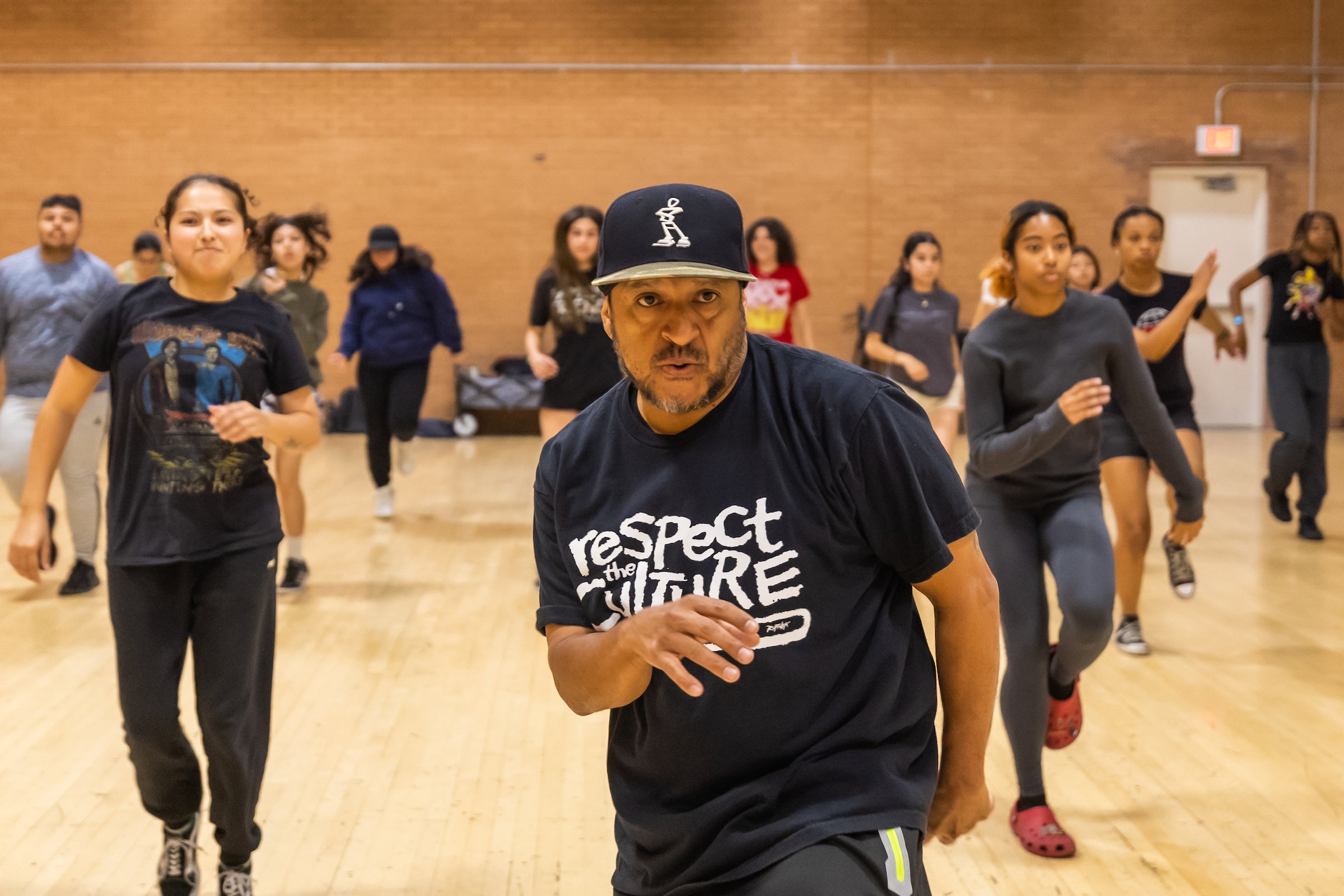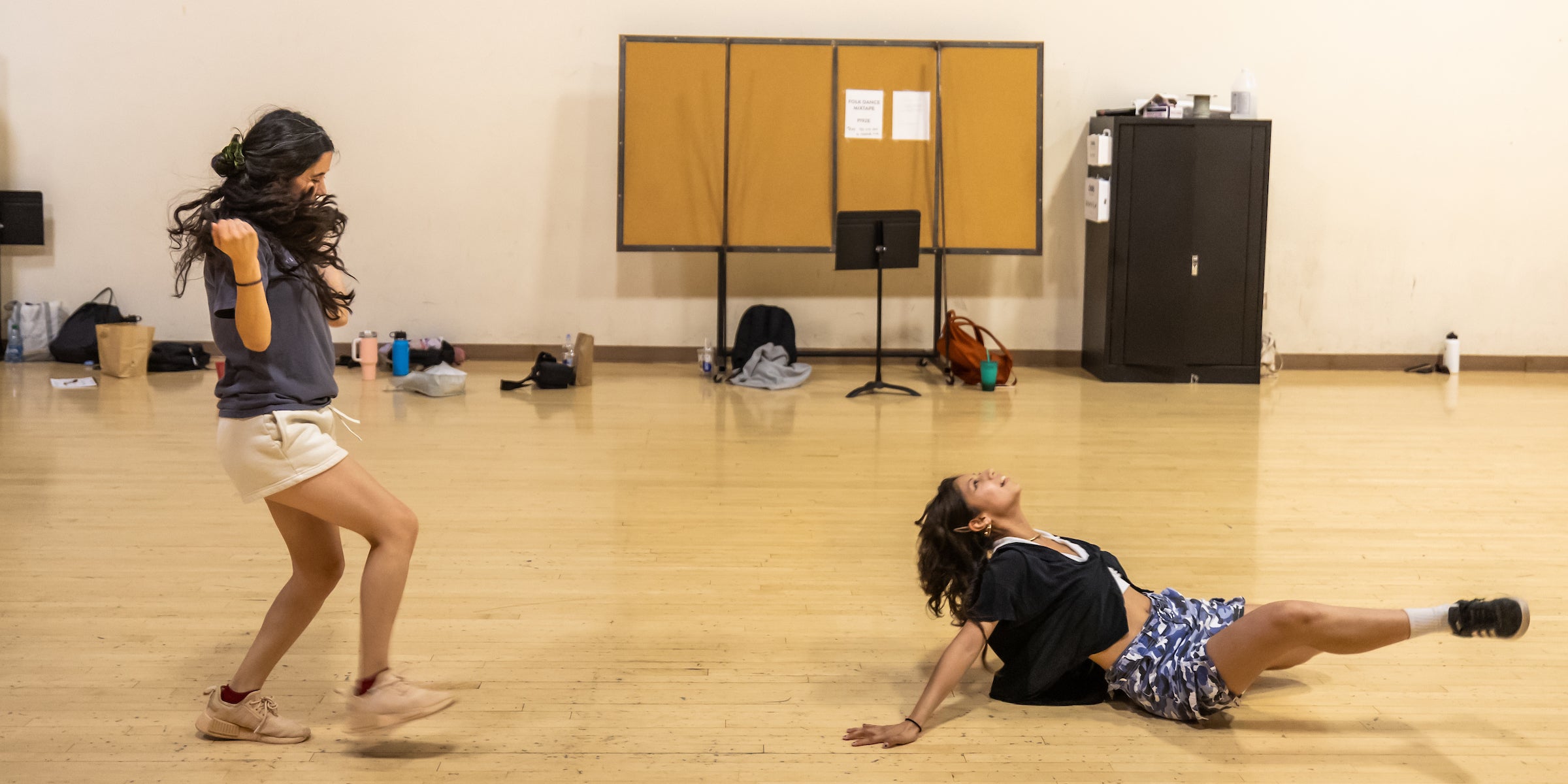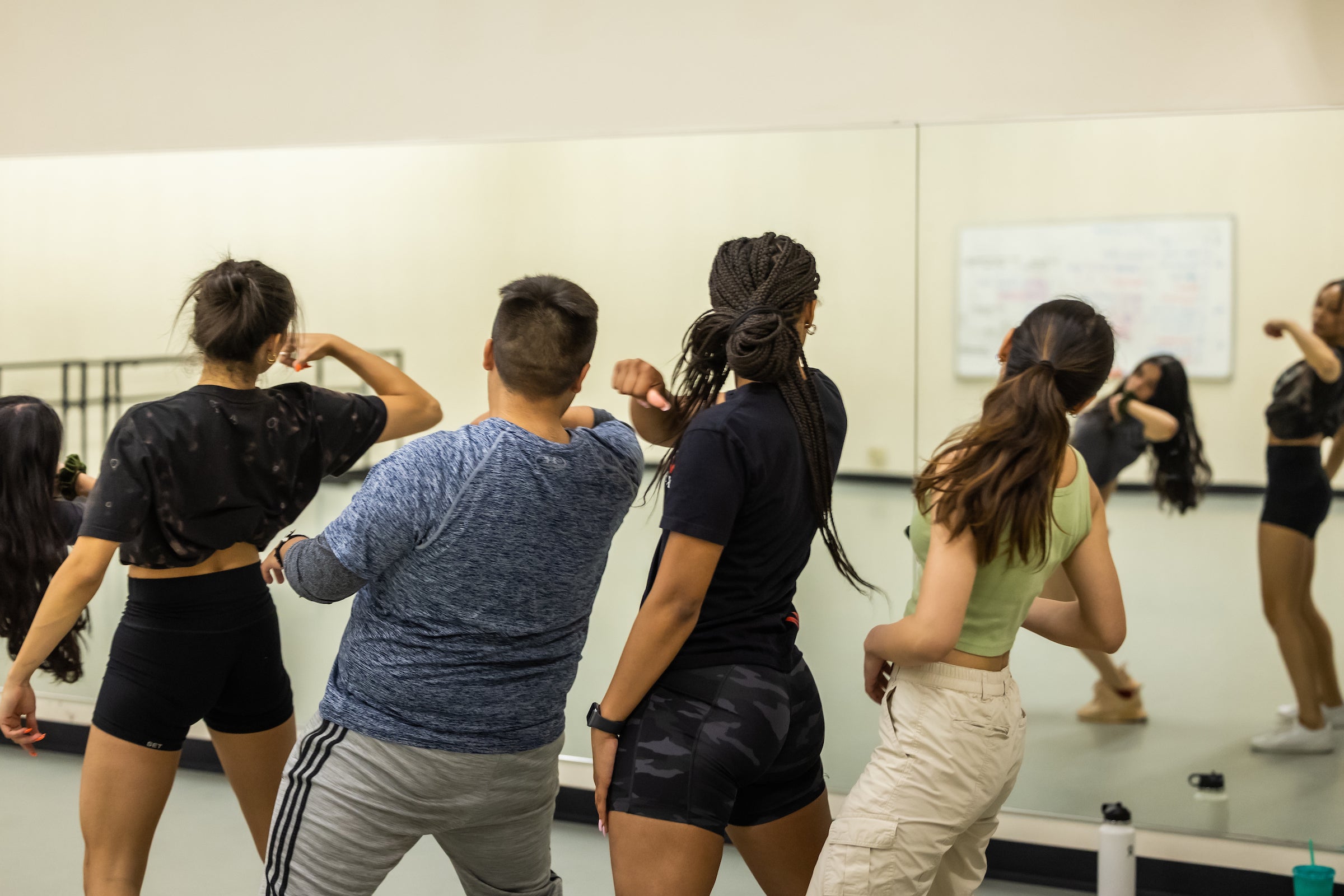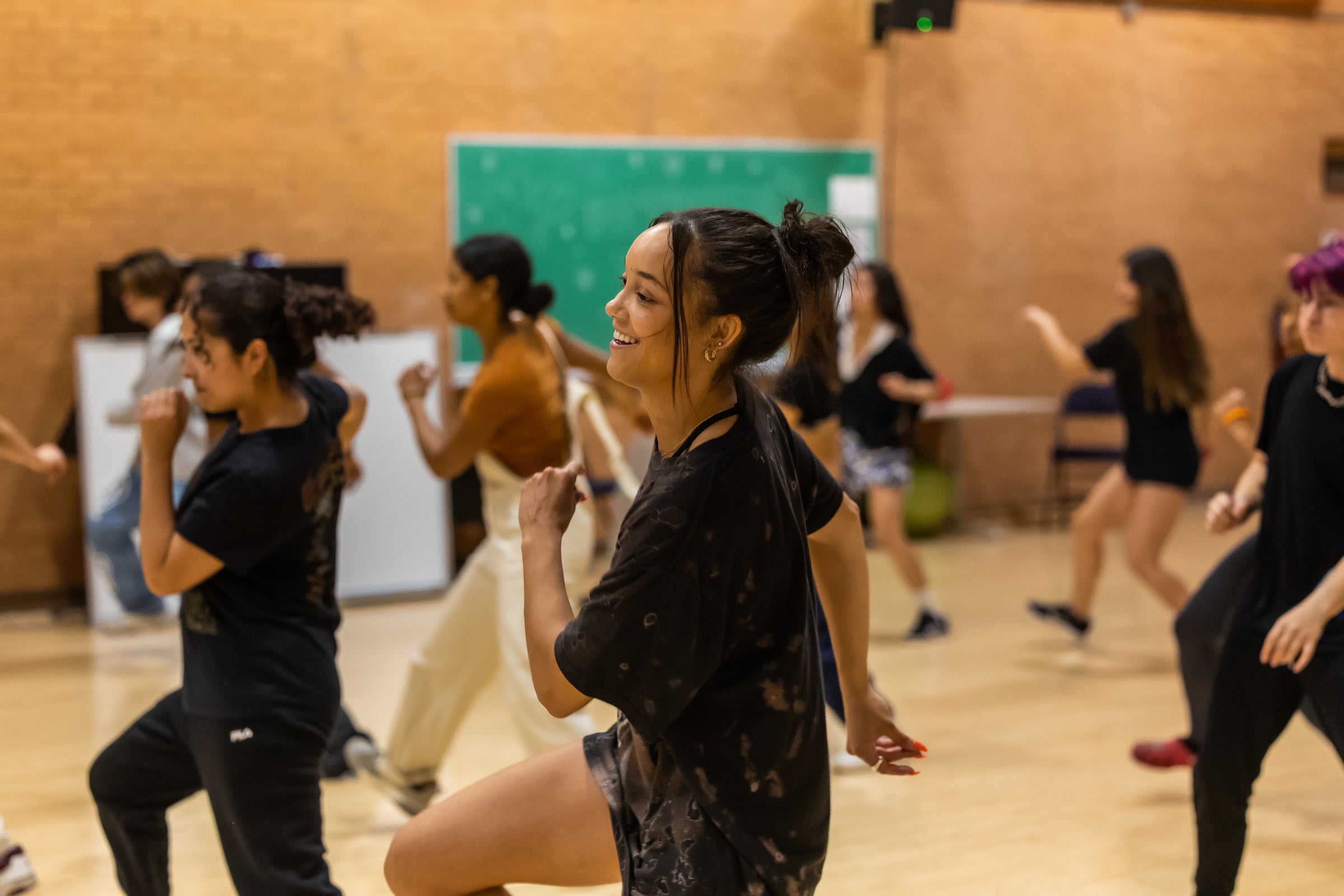Editor’s note: This story is featured in the 2023 year in review.
Hip-hop — that fresh, modern art form — is 50 years old.
The common origin story of hip-hop goes back to a house party in the Bronx on Aug. 11, 1973, when Kool Herc, a young DJ working the record player, played just the instrumental parts of the songs — the “breaks” — while his friend, Coke La Rock, talked on the microphone.
What started as a lively expression of 1970s house party music soon evolved into a reflection of life for Black Americans.
“I like to say that hip-hop is the ghetto CNN,” said Matt Kirkpatrick, a faculty associate in the popular music program at Arizona State University, who teaches about hip-hop.
“This was pre-social media. What avenue did we have other than going to parties and hearing stories and talking to one another?”
Hip-hop has grown to become an expansive culture of music, dance, fashion, art, language and identity that has been exported around the world and is now studied by scholars for political expression and gender construct.
RELATED: ASU Professor Mitchell Jackson weighs in on hip-hop style at 50 in Esquire
To mark the 50th anniversary of hip-hop, ASU News spoke with five experts at the university about different facets of the genre:
- LaTasha Barnes, an assistant professor in the School of Music, Dance and Theatre in the Herberger Institute for Design and the Arts. Barnes is an internationally recognized dancer, choreographer and award-winning competitor in Lindy Hop, house dance, hip-hop and waacking, and she teaches hip-hop dance. She calls herself “a tradition-bearer of Black American social dance.”
- Jerome Clark, an assistant professor in the School of Humanities, Arts and Cultural Studies in the New College of Interdisciplinary Arts and Sciences. Clark teaches a course titled “Indigenous Hip-Hop, Resistance and Kinship.”
- Matt Kirkpatrick, a faculty associate in the popular music program in the School of Music, Dance and Theatre. Kirkpatrick is a lifelong hip-hop lover who worked for many years in the radio and promotion fields. He teaches hip-hop music production and history.
- Jorge “House” Magana, a clinical assistant professor in the School of Music, Dance and Theatre. Magana teaches hip-hop dance and history. He also performs, teaches and judges hip-hop competitions around the world.
- Mako Fitts Ward is an assistant professor of African and African American studies and of women and gender studies in the School of Social Transformation in The College of Liberal Arts and Sciences and an affiliate faculty in The Design School in the Herberger Institute, as well as director of the Social Transformation Lab. She developed a course on gender and hip-hop, and she is writing a book about hip-hop artists who are women of color and their contributions to community-organizing work.
Jorge "House" Magana, a hip-hop performer and clinical assistant professor in the School of Music, Dance and Theatre, teaches a hip-hop dance class at ASU. Photo by Chris Goulet/ASU News
The birth of hip-hop
While the Bronx house party generally gets the credit for inventing hip-hop, Ward says that current scholars are looking beyond the New York City borough.
“Because of how people moved around the country during the time when we name hip-hop's origin — the '70s — we need to think about how maybe it didn't just start in New York — that it started all over the country in different places,” she said.
Geographic dislocation also makes it hard to pinpoint where Indigenous hip-hop was created, Clark said.
“Indian peoples, through various federal policies, were actively moved by the federal government from reservations to urban centers,” he said.
Some research has pointed to the late 1980s on the West Coast as the birth of Indigenous hip-hop. One of the early groups was WithOut Rezervation, based in California and composed of three men with different tribal affiliations.
What makes hip-hop, hip-hop?
At its core, Kirkpatrick said, hip-hop is beats and rhymes.
“It’s something dope — beat-wise, rhythmic or a loop — and somebody rapping a rhyming pattern over it, whether it’s four- or six- or 24-bar structures over that beat,” he said.
The beats are mastered by the DJ, who selects and plays the music, while the emcee raps the words.
The breakdancers are called B-Boys and B-Girls.
“The thing that makes hip-hop so amazing is that it’s not just a musical genre,” Kirkpatrick said. “You have the importance of the DJ, the emcee, the graffiti, the B-Boying, the dancing — all creating what the culture is.”
Magana said that hip-hop wasn’t called hip-hop in the early years.
“It was called breakers, or just ‘going off.’ It didn't have a name because it was just life.”
While breakdancing was the first hip-hop dance, often highlighting an individual dancer, Barnes said that the culture also includes moves by people in the crowd.
“We also do make space to celebrate those who didn't get on the floor but also partied. We usually call those party dances, like the Snake for those who were in the '80s, and the Roger Rabbit,” she said.
Hip-hop's evolution
The Sugar Hill Gang's "Rapper's Delight" became the first rap song to become a Top 40 hit, in 1979. The 15-minute song, which was cut in half in order to be aired on the radio, had lyrics about friends, cars, girls and celebrities. But hip-hop artists used their music to reflect all aspects of life for Black people in America.
“Everyone knows ‘Rapper’s Delight.’ If you close your eyes and listen, you can hear them rapping that at a house party,” Kirkpatrick said.
“Besides rocking parties and having fun, you have Grandmaster Flash and the Furious Five, and if you listen to their records, it rings true today. A lot of people like to brush under the rug what ‘gangsta rap’ evolved into, but they were referencing what they saw on the streets of Compton.
“It’s a clear evolution from that type of rap, very braggadocious about their sound system and DJ and crew, and fast-forward to drug use and overdoses and depression and gangs, very meaningful things that can be explored. There’s a lot of party, but hip-hop has always had, ‘Hey, look what’s going on in our neighborhood.’
“That’s the genius of Dr. Dre too. We want to have fun and chase girls, but there’s this other thing going on where our homies are getting killed and harassed by the police and we have to talk about it.”
Video by Josh Belveal and Alex Cabrera/ASU VisComm
Taking on colonialism
Indigenous hip-hop artists expressed what they were living with, too — colonialism and oppression, Clark said.
“They’re talking about what that looks like both in a national context and specifically what it looks like on the reservation,” he said.
For example, the songs of WithOut Rezervation address loss of tribal land, social injustice, cultural erasure and portrayals of Native Americans as violent or a mascot.
But there’s a wide range of hip-hop created by Native artists, he said.
“You also have songs talking about what it looks like to be a young Indigenous person in an urban context and hanging out with friends, and writing about love and lost love,” he said.
Indigenous hip-hop is a modern cultural act, Clark said.
“The way Indian people are thought about politically and culturally and the ideas of how they should look and act is based on Indian people of the past,” he said.
“And if you don’t resemble that image or that ideal, you are somehow less Indigenous. But we are very much modern and very much still here, and we exist culturally and politically.
“Hip-hop is an act of asserting life. This is one way we can say, ‘We’re here and alive, and we have something to say.’”
'Rollling around on the floor'
Breaking, or breakdancing, is considered the original hip-hop dance and originated in the Bronx, according to Magana.
Breaking consisted of “top rocks” — moving the top of the body — and then transitioning to the floor.
“That’s the DNA of breaking – footwork or downrocking some legwork,” he said.
Breakingdancing is not random, he said.
“My mom would say, ‘You're just rolling around on the floor.’ But it's very intricate patterns, very thought out, you know?”
Breaking includes influences from other forms, such as martial arts and tap.
Popping and locking — two separate dance forms — originated on the West Coast, Magana said. Dancer Don Campbell invented the “Campbellock” move, which was shortened to “locking.”
“It stems from dances like the Funky Chicken and the Funky Robot,” Magana said.
Popping came out of influences including miming and animatronics.
“When these forms are created, it's a reaction to the music and a reaction to what's going on in the world,” he said.
“And it's a reaction to what these kids have access to, to be able to watch.”
Before the internet and even before music videos were on TV, breakdancers hungered to see new moves, he said.
“So you could literally be at home and somebody would give you a phone call and be like, ‘Yo, there's somebody breaking at Dairy Queen.’ And you would run out there and be like, ‘You break, cool, let's battle!’” Magana said.
“And that was because we wanted that exchange. We wanted to learn. And so even the people that are your rivals or your competition, we were really just elevating each other.”
Students dance in Jorge Magana's hip-hop class. Photo by Chris Goulet/ASU
Connecting to hip-hop's roots
Barnes sees hip-hop on a full continuum of dance.
“By the continuum, I mean the cyclical evolution of these art forms. So not just the linear historiography of jazz to hip-hop, but how one continues to influence and inform new manifestations of it.
“So that would be, from my perspective, focusing on jazz first and then looking to funk, rhythm and blues, and that evolved into disco, house and hip-hop,” she said.
The jazz impact is seen in the structure and stylization of hip-hop.
“One of my favorites is the playing style of Charlie Parker and the rhyming signature of Busta Rhymes. It was just unmistakable to me. That’s an embedded influence that Busta Rhymes carries. It’s really powerful,” she said.
Common to the different dance forms is “the bounce.”
“Because they are African in their origin, they are earth-sourced, and the basic, fundamental or foundational aspect that sometimes gets overlooked when people are learning these forms is the bounce,” she said.
“And your application of the bounce is what denotes which particular form you're engaging in.
“The triple bounce gives us a specific jazz-swing feel. And then that four-on-the-floor bounce gives us that pulse for house. And then that grounded but also very breath-influenced deep bounce gives us our hip-hop groove.”
Both jazz and hip-hop were created in the Black community, became celebrated in the white community and then were exported globally as “the best of American culture,” she said.
“And are still, sadly, not celebrating the people that created it here at home. So it's a fascinating juxtaposition in their similarities.”
A different scene in every city
“With any art form that directly speaks to youth, like grunge or punk, it evolves in the underground of each city. In every city there’s a hip-hop scene, and every scene is going to be different,” said Kirkpatrick, who is from San Diego.
“Living on the West Coast, it was about palm trees and gang culture and parties because that’s what we saw.
“East Coast is about hustling and drug dealing and sitting in tall buildings — very dark, menacing and ominous.
“Down South it’s very upbeat and clubby because the club was the driver of a lot of music. If you listen to JID or Kris Kross, it’s very much party music, in the club, on the radio.
“In Memphis you have Three 6 Mafia, very soul-stack driven. Detroit was very gritty and dark. Houston is very much car culture — slow-and-roll, trunk-rattle music.”
New York was an epicenter for hip-hop dance as well, Barnes said.
“But as I always say when I'm teaching — people in the South weren't waiting for someone from New York to come down to teach them how to dance to the music. They were coming up with their own ways.”
Students learn hip-hop dance moves in a class taught by Jorge "House" Magana at ASU. Photo by Chris Goulet/ASU
Women in hip-hop
Ward said that she argues in her upcoming book that women have always been central to the development of hip-hop music and the culture. In fact, Sylvia Robinson, a Black woman who founded Sugar Hill Records, produced “Rapper’s Delight,” which sold millions of records.
“We talk about women emcees like Roxanne Shanté or Queen Latifah or Monie Love,” she said.
“And then moving through the '90s, the 2000s, we look at artists like Lil' Kim and Rah Digga, and the place of women across different subgenres of hip-hop music.”
Ward said there has always been tension between how corporate rap music presented women and how independent female artists presented themselves.
“So independent women artists, like Bahamadia or Medusa, are either not part of a record label by choice or want to maintain a particular distance to the corporate music industry,” she said.
Native women in hip-hop have addressed patriarchy and how colonialism is gendered, Clark said, citing the First Nation artist Eekwol as a favorite.
“These songs talk about what gendered violence looks like and specifically violence against Indigenous women,” he said.
“Hip-hop is one of the places they can talk about what’s happening in their communities. They’re writing from a position of reclaiming their matriarchal position in society.”
While women in hip-hop music are celebrated, according to Barnes, "Women in hip-hop with regard to the dance, not so much."
“Fortunately, icons like Big Lez (Leslie Segar), TweetBoogie and a few others are still actively present and — as we say — will still actively throw down and show you why they are who they are.”
“I most readily credit the full empowerment of women in hip-hop, particularly on the dance side of things, to Michele Byrd-McPhee and the efforts that she's pioneered with the Ladies of Hip-Hop organization,” she said.
“It’s not just the battles, not just the showcases, but her efforts to educate and to ensure that women and girls have a space to celebrate themselves in hip-hop culture."
Students practice in an ASU hip-hop class taught by Jorge "House" Magana. Photo by Chris Goulet/ASU
New business models
“In the 1970s and '80s, the record labels were the gatekeepers, and it was, ‘Only the people we allow through the gate will be here.’ There was a time and a place for that, and it created phenomenal music,” Kirkpatrick said.
“But now there is a more even and level playing field for anybody who is interested in sharing any type of music they do. You can record yourself and put it on social media within an hour and get people to comment on it. That’s the upside to the technology we have now.”
Kirkpatrick sees the erosion of big record labels.
“I think hip-hop has not been afraid to embrace new technology and new ways of doing things faster than other genres of music. I think you’ll see more brand partnerships and brand cooperative releases versus the traditional record labels,” he said.
“In the past, there was always this conversation in the culture about, ‘Oh, am I selling out? Am I selling my music to sell other products?’" Ward said.
“That conversation isn't as robust as it used to be, in the ‘90s and 2000s, because now that's really one of the only ways that artists who aren’t heavily engaged in the corporate industry make their money. They have to diversify their streams of income.”
Ward writes about the impact of streaming in her upcoming book.
“The restructuring of the music industry has created opportunities for certain artists to really have agency over what they choose to write about, what they choose to produce and then how their music gets out to a global audience.”
Why does hip-hop resonate globally?
Ward said her answer, as a fan, is: “There's something that is hyper modern about rap music. The process of remixing is a heightened postmodern exercise. It's a very modern way of engaging with the past, through sampling and remixing.
“It’s also about nostalgia. It's about homage. It’s about this kind of holding onto a lineage through sound to Black music specifically.
At the same time, hip-hop is individualistic, she said.
“There is this ethic, this kind of adage of not only keeping it real, but this desire to always put front and center the absolute freedom of the individual.
“I liken the contemporary movement of hip-hop music to the Harlem Renaissance, and artists like Zora Neale Hurston, and Langston Hughes, and Countee Cullen, and others who were making arguments about art as sites for absolute freedom, and how artists, particularly Black artists and artists of color, have to have the freedom to produce and express themselves without the constraints of respectability, politics, racism, sexism, etc.
“And I think that there's something very appealing worldwide about that message.”
More Arts, humanities and education

Professor's acoustic research repurposed into relaxing listening sessions for all
Garth Paine, an expert in acoustic ecology, has spent years traveling the world to collect specialized audio recordings.He’s been to Costa Rica and to Ecuador as part of his research into innovative…

Filmmaker Spike Lee’s storytelling skills captivate audience at ASU event
Legendary filmmaker Spike Lee was this year’s distinguished speaker for the Delivering Democracy 2025 dialogue — a free event organized by Arizona State University’s Center for the Study of…

Grammy-winning producer Timbaland to headline ASU music industry conference
The Arizona State University Popular Music program’s Music Industry Career Conference is set to provide students with exposure to exciting career opportunities, music professionals and industry…






